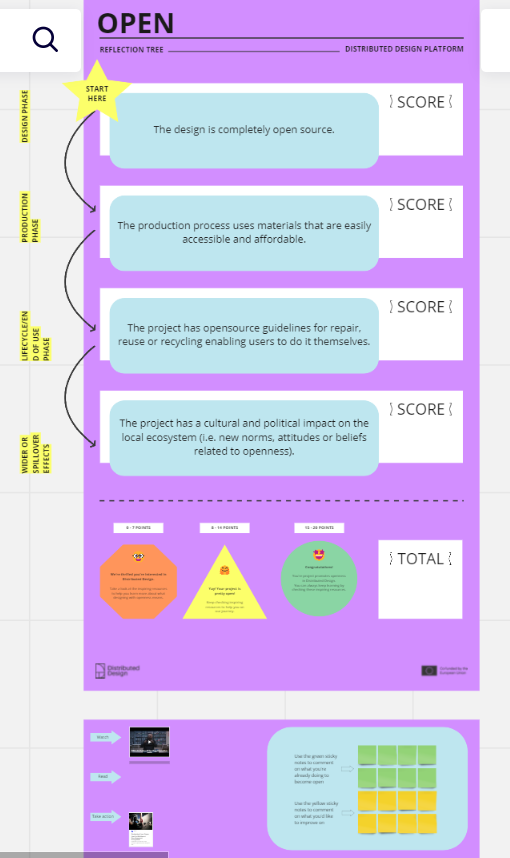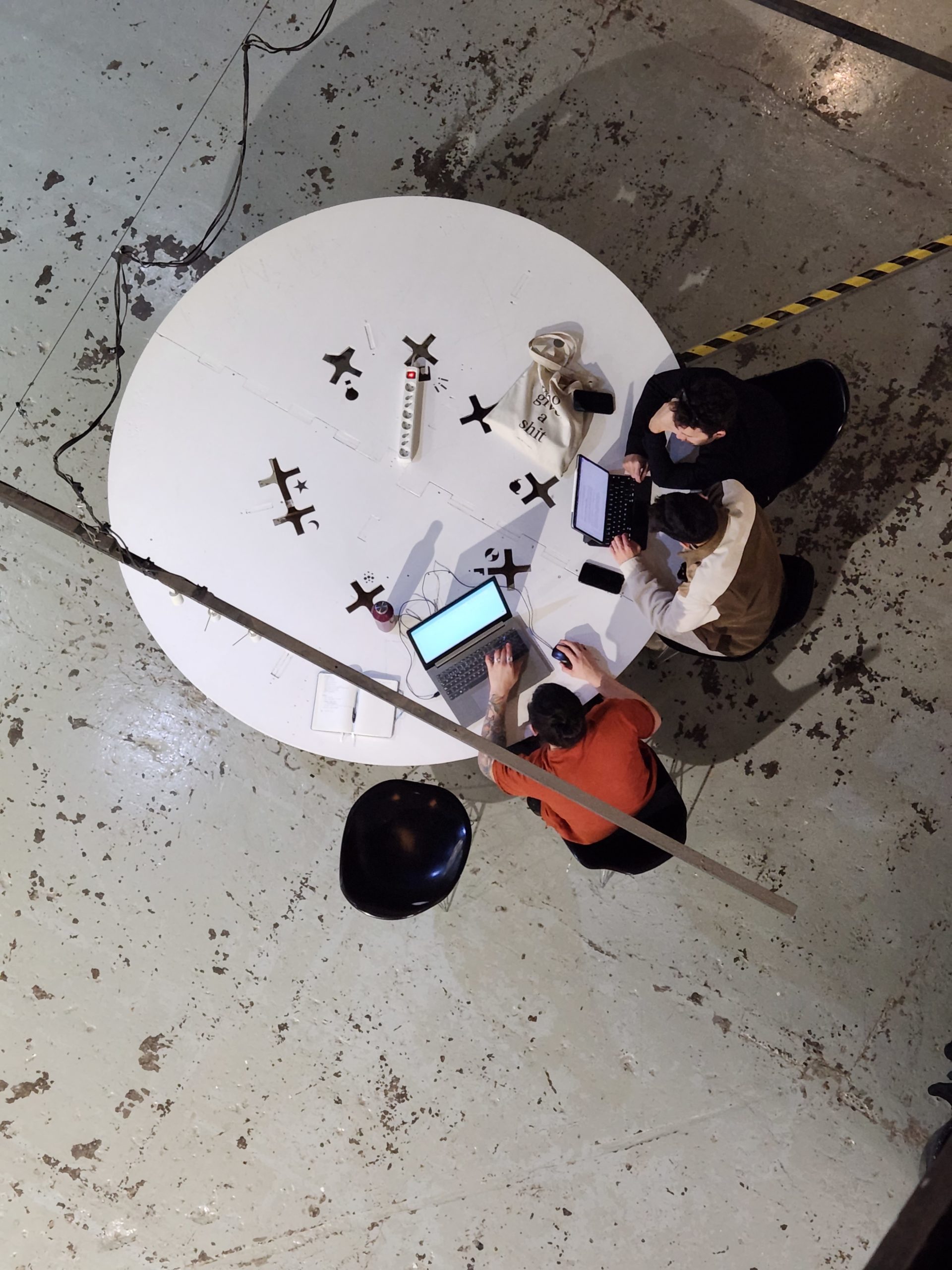The Distributed Design Platform Reflection Tree is meant to help creatives reflect on where their project is on its journey to becoming Distributed Design. The Tree is meant to encourage creatives to think about their work at four intervention points and inspire them to continue connecting to the Distributed Design values. The Tree was created as part of the Distributed Design Platform Impact Report, a report that will help us understand the social and environmental impacts of Distributed Design on the creative and design industries.
Why a Reflection Tree?
We have created this Reflection Tree for several reasons.
1) To inspire designers and creatives to connect their design processes to the Distributed Design values and help them understand where their project is on the path to becoming a Distributed Design. The statements in the tree are inspirational and show the direction we hope the field will continue to move in.
2) To help us understand the social and environmental impacts of Distributed Design on the creative and design industries. The Distributed Design Platform will collect qualitative and quantitative responses to the Tree to make this assessment in the form of an Impact Report.
3) Creative talents’ participation in using the tree will help us identify how the Distributed Design Platform can better provide meaningful resources to our community. For example, in seeing participants are scoring low in the value “collaborate” we’d identify opportunities to support creatives to work more collaboratively through dedicated webinars, workshops or toolkits.

Features of the Reflection Tree
The Reflection Tree is vertically divided into each of the four Distributed Design Platform values: open, collaborate, regenerate (further broken down into regenerate socially, environmentally and regenerate value), and ecosystemic. Creative talents are asked to move through the values and reflect on a series of affirmations related to each. This will help them generate a score for them to get an idea of how related their work or project is to the selected Distributed Design Platform value.
The values are listed in this order because:
- We consider openness to be a pre-condition of Distributed Design. An essential feature of Distributed Design is designing for replication, so if a creative talent is not available to the idea of openness, it is hard for them to apply Distributed Design to their project
- We consider that exploring and having knowledge around how to work collaboratively is the next step towards applying Distributed Designer to an initiative.
- Next are the values related to regeneration. Once you’ve established that you can work collaboratively, we believe that you’re able to assume the responsibility of the social and environmental impact that one’s design will have.
- The last value is ecosystemic. We believe that working ecosystemically is a feature of systems thinking and is the most complex to achieve, which is why it is last in the line of values.
The tree is horizontally divided by three stages of intervention and a fourth stage related to overarching impact: the design phase, production phase, lifecycle, end-of-life phase, and lastly, wider or spillover effects. This last section relates to the overall impact of a designer’s intervention and relates to their capacity to apply systemic design to their work.

We have used these four stages to offer an example of when you might stop and reflect. It is important to note that, in practice, the design process is a complex one: a designer will likely never move through these four stages in a unilateral direction, but go back and forth between stages, i.e. between the design and production phase while testing prototypes. We have used these four stages to offer an example of when you might stop and reflect
Finally, the bottom row of the template is dedicated to resources that talents can read, watch or use to take action. They are meant to help inspire participants to continue their journey toward creating projects that are more open, collaborative, regenerative, and ecosystemic. At this point, we encourage participants to use sticky notes to reflect on how their project is related to the selected value and how they could improve the relationship to the value.
Reflection Tree Development: Process & Considerations
The Reflection Tree was developed by the Distributed Design Platform through an iterative process involving desk research; focus groups with Distributed Design Platform members– Ars Longa, Happy Lab Vienna, MAKER, Polifactory at Polimi and Fab Lab Barcelona— and experts from former members at Other Today; and workshops with selected creative talents.

From these sessions, we gathered several major reflections:
- The affirmations used in the Tree should be inspirational and holistic to encourage Creative Talents to engage values in their design process.
- Preparing the Tree provided the space for us to reflect on the Distributed Design Platform values and to reconsider them. Over the next months, we will be revisiting and reimagining our values to ensure they align with the large cultural and consciousness shifts that have occurred since the Platform was founded. One of the biggest changes so far is that the “sustainable” value has shifted to “regenerate” and the values are now verbs to reflect their actionability. The revised values will support the Reflection Tree: they will show what it means to be open, collaborative, regenerative, and ecosystemic while the Tree will illustrate practical moments to engage with these values.
- The Reflection Tree and re-considered Distributed Design Platform values should connect to other methodologies, approaches, and theories of design. For example, assuring that it’s situated within the circular economy, designing for the pluriverse or designing for Ancestral Futures. Distributed Design is compatible with other methodologies and can enhance these fields, and vice versa.
- The values and Reflection Tree should connect to not only the distribution of making but to the distribution of knowledge, value, and power as well. This language is illustrated in the affirmations in the Reflection Tree, the reimagined values, and our conversations around what Distributed Design means today.
Next Steps
The first iteration of the Distributed Design Platform Reflection Tree is about to go through a round of testing with the students from Fab Lab Barcelona’s Master’s in Designing for Emergent Futures. During a three-day seminar, students will: learn about Distributed Design; practice applying the Reflection Tree to their term projects while providing each other with feedback; reflect with us on the Distributed Design values and their evolution. Following this last phase of testing, we will release an analog and digital version of the Reflection Tree on the Distributed Design Platform website in the resource section.

In parallel, we are preparing new iterations of the Distributed Design values and briefs on each. Since the Distributed Design Platform was founded in 2017, the world we live in has evolved and so have the fields of creativity and design. We want to make sure the values reflect the present we want to see now and also serve as inspiration for our designers, encouraging them to take into consideration schools of thought, approaches and methodologies like Doughnut Economics, queer ecologies and decolonizing design. We hope to unveil the reimagined values later this year.
Over the next year, we will begin to deploy the Reflection Tree with Distributed Design Platform creative talents to better understand their relationship to the values and which resources we can provide to support them.
We are excited about this next step in the continuous evolution of the Distributed Design Platform, to better understand our impact on the creative and design fields and to develop meaningful resources for our community. Stay tuned for more. Here, you can begin to use the Distributed Design Platform Reflection Tree in its current form.
